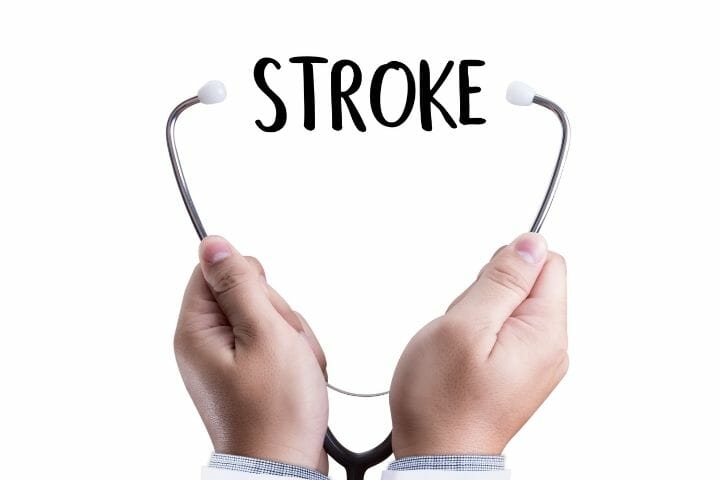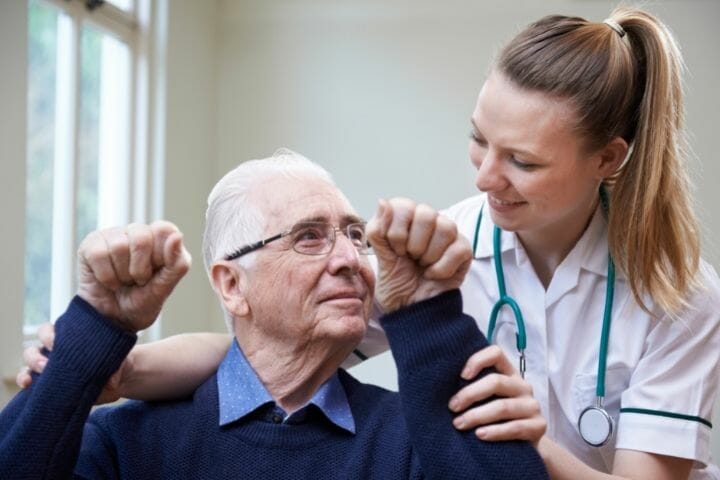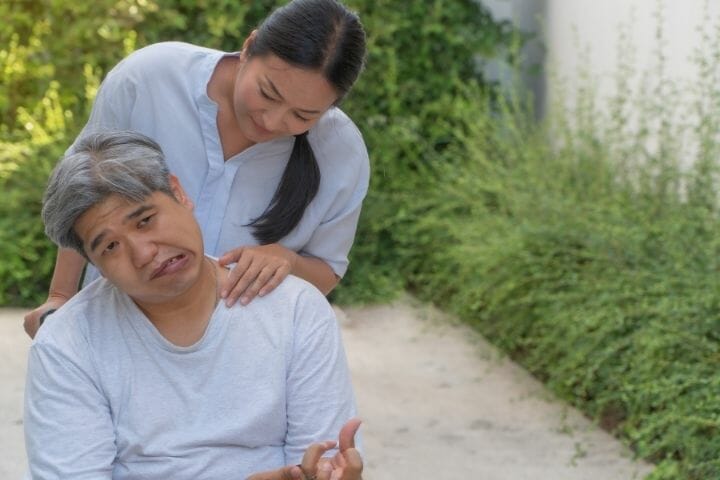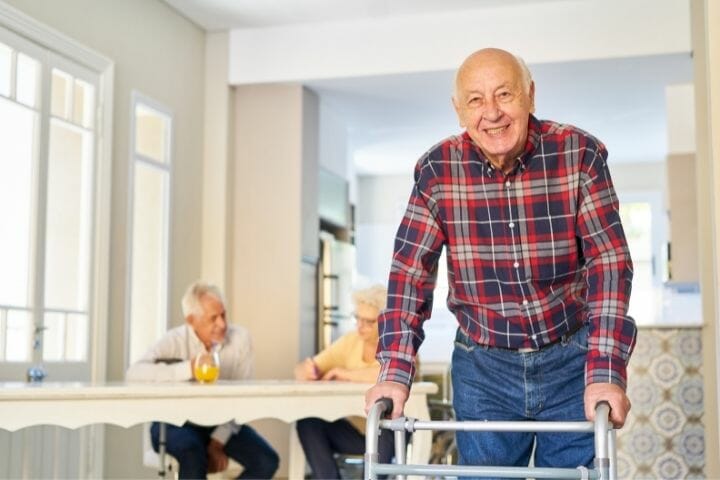Life is no longer the same for the elderly after the occurrence of a stroke. Here are simple tips and tricks for the caregiver to navigate the recovery process and nurse a stroke survivor back to optimal health.
Contents
According to the World Stroke Organization, more than 13 million people worldwide fall victim to a stroke every year. It is the leading cause of death and disability among Americans aged 60 and above.
Most older adults undergo a severe degradation in their quality of life after a stroke, making the stroke recovery journey challenging and confusing for both the senior and caregiver.

Thus, we bring you this guide to help you serve as a proficient caregiver and support the stroke survivor in every way possible.
What to Expect After a Stroke?
Stroke patients are known to suffer from various disabilities based on –
- The intensity of the stroke
- How early does the senior receives medical attention
- The part of the brain affected
- The older adult’s overall health before the stroke
In the first week after the stroke, the primary health care team carefully determines all the side effects and their extent to formulate an informed plan of the rehabilitation measures.
Cognitive Impairment
One of the most common side effects of a stroke among the elderly is cognitive difficulties and speech disorders like Aphasia, Apraxia, and Dysarthria.
As the brain fails to regulate sensory control of the vocal cords, tongue, jaw, and lips, the patient struggles to speak normally and string words to form sentences. In more severe cases, the patient loses the memory of all previous words and feels they have to learn the language from scratch.
Physical Effects
A major challenging aspect after a stroke refers to the physical side effects. Due to loss in muscle mobility and strength, older adults suffer from Complex Regional Pain or Shoulder-Hand-Syndrome. This syndrome causes sudden hot, cold, and tingling sensations in the upper limbs on the affected side.
However, at times even the unaffected side can undergo pain and numbness as the aged person places more strain on that side after a stroke for basic functioning. The syndrome can advance to full or partial paralysis in the arms.
Some stroke patients experience extreme tightness and stiffness in their muscles and joints – spasticity. As a result, they are unable to perform any involuntary movements independently. The seniors are heavily dependent on crutches and wheelchairs to get through a day as their coordination is greatly affected.

Emotional Changes
It is usual for stroke survivors to experience feelings of frustration, anger, shock, and grief as they navigate a life filled with heavy physical limitations, discomfort, and uncertainty.
In the months that follow a stroke, the senior takes a hit on their self-esteem and confidence which leaves them more vulnerable to being emotionally overwhelmed. If they continuously fear getting another stroke, other symptoms, family, or the future in general, they might frequently trigger anxiety and panic attacks.
If the prolonged sense of hopelessness and dread in the senior is left unaddressed, it can develop into depression in the future. Thus, the elderly should be motivated to seek help and support from mental health professionals to better cope with the losses and changes.
Stroke Rehabilitation Priorities
There are no established guidelines on this, but stroke rehabilitation should be initiated as early as possible, even 24 hours after the stroke if the patient is medically stable, for the best results.
At-home care with the aid of a caregiver is the most preferred option for stroke survivors with a moderate level of impairments. Staying in a familiar environment will speed up their recovery as they feel safe, surrounded by their loved ones.
Physical Therapy
The first goal of stroke recovery is usually to restore the fundamental motor functions among seniors.
Initially, you have to aid the patient in moving between their bed and chair, standing, sitting up, and walking. Once the patient starts to show improved agility in these tasks, you can encourage daily rehabilitation stroke exercises.
Exercise is considered the best remedy for stroke as it can effectively build endurance, increase walking speed, relieve stress, and provide the patient with a goal to work for.
For the best outcomes, you should focus on muscle resistance and the cardiovascular fitness of the aged individual. Stationary cycling, walking on a treadmill, and cross-training will get the stroke patient’s heart pumping and make them feel better.
Resistance training exercises like hand stretches, knee rotations and raises, wrist curls, shoulder openers, trunk bends, and hip thrusts/abductions can play a vital role in helping the stroke patient overcome paralysis and expand their range of motion.
The key to achieving swift progress with a stroke survivor is – consistency and repetition to rewire the brain’s familiarity with the tasks.
Thus, stroke exercises should ideally be done in at least ten to fifteen repetitions at least three-five times a week. However, always seek the approval of the primary doctor regarding the frequency and type of exercises that are optimal for the senior after a stroke.

Occupational Therapy
As the caregiver, you should engage the stroke patient in occupational therapy to slowly revive their involvement in the daily living tasks.
In the first stage of recovery, the stroke patient has almost zero control over their limbs and minor vision loss. Thus as the caregiver, you should initiate various home modifications to ensure maximum patient safety.
You should consider decluttering your doorways and walkways to facilitate the smooth movement of wheelchairs. Get rid of doorknobs that need twisting or locks to ensure that you can easily access the elderly patient at all times.
Bathing & Grooming
After a stroke, the elderly individual has worsened balance and is more likely to suffer accidental falls. That is why you must get grab bars installed on the bathroom walls, by their beds, stairs, and also place non-slip floor mats and carpets around the house to prevent injuries.
Since getting in and out of a bathtub will be pretty tricky for a stroke survivor, a shower will be better for bathing the older adult. You can even consider investing in raised toilet seats with armrests on both sides.
Get them seated on a shower stool comfortably as the weakness in their feet would not allow them to stand throughout the bath time without pain. While transferring them from the wheelchair to the stool, ensure that the footrests are not in the way and the brakes are on.
Keep all the essential bathing supplies like soap, sponge, shampoo, and towels ready within the senior’s reach beforehand to minimize panic. You can even keep the liquids in travel-size bottles so that the patient can use them individually with one hand itself.
Investing in smart grooming supplies like an electric razor, a toothbrush with extended handles, toothpaste with flip openings can go a long way in making the self-care and grooming routines easier for the senior after a stroke.
You can let the individual move ahead with their routine if their hand movement isn’t entirely restricted. Aim to stay nearby but not actively intervene in their actions unless they ask for assistance. Only, if the person cannot lift their arms at all, you can use a hand-held shower to wash them.

Dressing Up
Initially, the stroke patient will find independent dressing quite frustrating, but you must be patient and reassure them to take as much time as needed. You can help them by taking out their clothes from the closet and helping the patient to stay seated.
Make them practice taking off clothes from their affected side first and then using their strong hand to pull sleeves up the affected side. Also, choose loose-fitting clothes made of stretchable fabrics to enable the patient to wear them without hassle.
Adaptive clothing and shoes that come with strings, velcro closures, elastic waistbands, and button hooks can also aid the senior in dressing up quickly. Also, you can keep a footstool to help them put on socks and shoes without bending down much.
Eating
After a stroke, the senior can suffer from dysphagia and find it difficult to swallow normally. The stroke survivor is at the risk of choking in the early days of recovery as the brain fails to activate muscle reflexes in the throat quickly enough.
The individual must receive adequate nourishment from food to maintain their energy levels, which is needed for the various rehabilitation activities in the day.
Many seniors face difficulty in chewing and swallowing as the brain delays the reflex response at the back of the throat.
Thus, the caregiver should prepare pureed or soft foods like mashed potatoes, applesauce, and overcooked lentils to ensure that the patient is well-fed. Otherwise, fruits and vegetables can be cut into small pieces and put in a blender to make them soft.
Take your aging loved one to a speech therapist if the swallowing problem persists even after the first few weeks. They will recommend jaw exercises and muscle relaxers to help the throat open easier.
The brain damage caused by the stroke can affect the elderly individual’s sense of taste and smell, resulting in a loss of appetite. To combat this, you must add strong herbs and spices for flavoring. Give the patient a hearty breakfast filled with high-calorie foods to stimulate their appetite.
A stroke can also affect a person’s ability to hold spoons, forks, and knives. Make the switch to using smart utensils for the stroke survivor. Spoons with oversized handles, plate guards, battery-operated peelers, and rubber pads to keep the plates in one place will assist the individual in completing their meals on their own.

Brain Exercises
Developing hobbies that stimulate the brain is crucial to the healing process. Here are five brain exercises that the caregiver and senior can partake in together :
- Games – Playing board games can boost stroke survivors’ problem-solving and information retention skills and heal their cognitive disability.
- In today’s digital age, stroke patients can also use their smartphones and laptop to play games on brain training apps like Lumosity, Aura, Tactus Therapy, and Thinking Time Pro.
- Making the afflicted individual solve traditional puzzles, including crosswords, sudoku, and word searches effectively improves their short-term memory.
- Art Therapy – Involving a stroke survivor in simple art and craft projects that require them to paint, draw, color can stimulate multiple vital parts of the brain. These activities actively strive to restore their hand-eye coordination, protect the senior from boredom and act as an outlet for creative expression.
- Play the favorite songs of your aged loved ones to motivate them to sing along, which will prove conducive to their speech recovery. Listening to music will also improve their overall mood, increase their attention span, and adopt a more positive attitude.
Maintaining Order
In-home caregivers are also responsible for maintaining order and stability in the lives of stroke patients by keeping track of all their essential tasks, including doctor appointments. They should leave reminders in the form of sticky notes around the house and alarms on the phone to train the aged patient’s memory.
The caregiver must collaborate with the stroke survivor’s primary healthcare team and occupational and physical therapists to ensure continuity in treatment and care.
Since individuals are put on several medicines that serve different purposes, you must closely monitor their side effects and immediately inform the doctor if any symptom seems out of the normal.
Reducing The Risk of a Stroke
Stroke patients are always at a high risk of a recurrent stroke; therefore, the caregiver should ensure the patient leads a healthy life by eating a balanced diet, exercising regularly, taking their medicines, and getting routine health check-ups.

Wrap Up
As recovery never looks the same for everyone, do not allow yourself or your aged loved one to be disheartened by a lack of drastic changes. The progress can be uncertain at times, but you must push through with your caregiving efforts as the brain can regenerate even decades after a stroke.
A caregiver plays a significant role in the life of a stroke patient; that is why it’s also important for you to look after yourself and manage your stress efficiently to prevent caregiver burnout.
We have tried to delve into every essential aspect of caregiving after a stroke in this guide; if this information has been of any help to you, please share it with your friends, family, and on social media for greater awareness.
If you have any suggestions of your own about caring for a stroke survivor, please leave them down below in the comments section for our readers.
